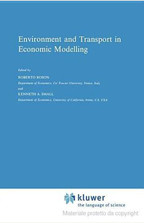Environment and transport in economic modelling

01.03.1998
Roberto Roson, Kenneth A. Small
Kluwer Academic, Series on Economics, Energy, Environment
The analysis of relationships between transport and environmental policy
has rightly invited interdisciplinary treatment and a variety of
approaches. An important subset of the approaches used involves economic
analysis. Economic approaches often consider pricing policies and
attempt to evaluate their effectiveness in comparison with more
traditional measures such as “command and control” regulation and
directed technological innovation. Another important subset of
approaches involves simulation modelling, in which key relationships are
represented mathematically so that their influence can be quantified
and their inter-relationships discerned precisely. This book treats the
intersection of these two subsets of approaches: simulation models with a
strong economic content. This intersection defines a broad but powerful
way to study environment and transport. Its breadth is illustrated by
the wide range of policies, from carbon taxes to speed limits, treated
here. Its power comes from putting insights about inter-related actions
and the role of markets – the strong points of economic theory – into a
from suitable for making quantitative predictions about the results of
policies.
Contributors: A. Alberini, J. Bates, B. De Borger, W.
Harrington, G. Harrison, B. Kriström, V. McConnell, P. Peeters, J.
Peirson, G. Pireddu, P. Rietveld, R. Roson, T. Shoemaker, D. Swysen, A.
van Binsbergen, R. Vickerman
The analysis of relationships between transport and environmental policy has rightly invited interdisciplinary treatment and a variety of approaches. An important subset of the approaches used involves economic analysis. Economic approaches often consider pricing policies and attempt to evaluate their effectiveness in comparison with more traditional measures such as “command and control” regulation and directed technological innovation. Another important subset of approaches involves simulation modelling, in which key relationships are represented mathematically so that their influence can be quantified and their inter-relationships discerned precisely. This book treats the intersection of these two subsets of approaches: simulation models with a strong economic content. This intersection defines a broad but powerful way to study environment and transport. Its breadth is illustrated by the wide range of policies, from carbon taxes to speed limits, treated here. Its power comes from putting insights about inter-related actions and the role of markets – the strong points of economic theory – into a from suitable for making quantitative predictions about the results of policies.
Contributors: A. Alberini, J. Bates, B. De Borger, W. Harrington, G. Harrison, B. Kriström, V. McConnell, P. Peeters, J. Peirson, G. Pireddu, P. Rietveld, R. Roson, T. Shoemaker, D. Swysen, A. van Binsbergen, R. Vickerman
